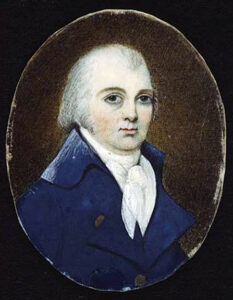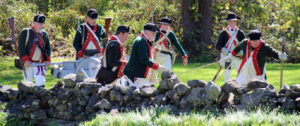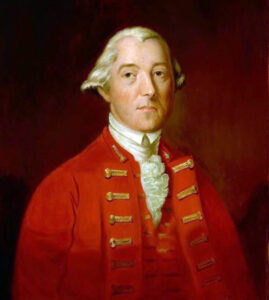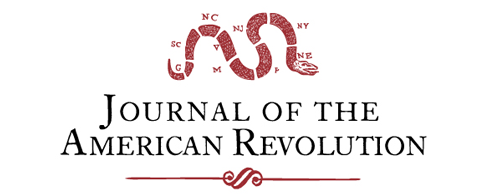In 1776, the Declaration of Independence charted a new autonomous path for thirteen of Britain’s North American colonies. One of the document’s many allegations was that British authorities had “excited domestic insurrections amongst us.”[1] While its context largely pointed towards Native Americans, another inspiration for this grievance may have been the embodying of Loyalist regiments in 1775 and 1776. Eventually thousands of colonists joined these military units to preserve the North American portion of the British Empire. Two weeks before the enactment of the Declaration of Independence, one of these Loyalist regiments was formed under extraordinary circumstances: The King’s Royal Regiment of New York commanded by Sir John Johnson.

Ironically, the unit was founded not in the colony of New York, but rather in Québec, also commonly referred to as Canada. In the early summer of 1776, Québec Gov. Guy Carleton was completing the colony’s liberation from a Rebel army. The year before, a force under generals Richard Montgomery and Benedict Arnold had invaded Québec, conquering the settled areas up to the walls of the City of Québec. In the spring of 1776 a British relief force arrived, which ousted the occupiers in an ensuing campaign.[2] At the tail end of this operation, Carleton unexpectedly encountered New York resident Sir John Johnson and 200 of his refugee neighbors near Montréal.
Johnson was a large landowner in the Mohawk River area in the colony of New York, and more importantly, a notorious Loyalist. He and his weary group had just escaped a grim situation in central New York, whose Loyalist and Rebel factions were hurtling towards civil war. Soon after meeting Johnson near Montréal, Carleton wrote to Secretary of State for the Colonies, George Germain, relaying intelligence conveyed by the refugee Loyalist leader: “He represents to me that there are considerable numbers of people, in the part of the country he comes from, who remain steadily attached to His Majesty’s Government and who would take up arms in its defence had they sufficient protection . . . in the meantime they suffer all the miseries that the persecuting spirit of the rebels is able to inflict upon them.”
Not awaiting instructions from London, and reasoning that it was a sensible policy, Carleton informed Germain that he created a new Loyalist regiment for Johnson and his followers:
Taking it for granted that the King’s pleasure is, not only to furnish all his good and loyal subjects with the means of defending themselves against rapine and violence, but further to grant them all possible assistance, I have therefore given Sir John Johnson a commission to raise on that frontier of this province a battalion of men (to be called the King’s Royal Regiment of New York) of equal number of the other [of] His Majesty’s marching regiments serving in America, and I have appointed him Lieutenant Colonel commandant thereof.[3]
The specific date of the genesis of the King’s Royal Regiment of New York—the date of Carleton’s commission to Johnson—is commonly cited on the regimental muster rolls as June 19, 1776.[4] Several months later, Johnson referred to the regiment as “a force sufficient for me to stand upon my legs and look my enemies in the face.” This was a natural reaction to the political volatility that Johnson and his Loyalist friends had experienced with their numerically-superior rebellious neighbors back in the Mohawk River area of New York.
The idea of the regiment originated well before this date, however, and entailed a series of extraordinary events that set the King’s Royal Regiment of New York apart from other Loyalist corps. Johnson told Carleton in 1776 that the 200 men who formed the regiment’s basis were “part of a much larger body we had raised.”[5] The early percolations of the regiment were detailed by Maj. James Gray, who was the regiment’s second-in-command and often its de facto commander due to Johnson’s frequent absences. In a postwar memorial, Gray stated that several months prior to the encounter with Governor Carleton, he travelled from his home near Albany to Johnstown, New York to meet with Johnson and other Loyalist leaders at Johnson Hall. Their objective was to coordinate a strategy to oppose the growing rebellion in the colonies. “It was agreed to engage and embody one thousand men for this purpose,” Gray wrote, “who were to join His Majesty’s troops on their arrival in New York, and a list was made out of gentlemen who were to serve as captains and to be appointed by his Excellency Lieutenant General Tryon the Governor of the Province.” The original intention, therefore, was to organize and travel southward towards New York City, rather than northward towards Québec; subsequent events dictated this change in direction. Gray claimed that by January 1776 he had already recruited 700 men to serve in the future regiment.[6] That number of able-bodied soldiers was more than sufficient for an entire battalion.
Before their plan could be executed, a series of tense events took place in the neighborhood of Johnstown, New York, that would delay the effort. In January 1776 Congress was concerned about rumors of Johnson and his Mohawk River followers’ support for the Crown in the developing conflict. Maj. Gen. Phillip Schuyler, the main Rebel military commander in the north, consequently wrote to Johnson on January 16. He asked for a meeting to discuss Johnson’s political position and his role in “designs of the most dangerous tendency to the rights, liberties, property, and even lives of those of His Majesty’s faithful subjects in America who are opposed to the unconstitutional measures of his ministry, [that] have been formed in a part of the County of Tryon.” Schuyler’s description of the Rebels as “faithful subjects” at this time highlights the significant philosophical changes forthcoming with the signing of the Declaration of Independence later in 1776.
In his letter, Schuyler underscored that he wanted a peaceful gathering with Johnson. He hoped that no blood would be shed, but he also brought scores of Rebel troops to reinforce his words. When the two men met in person the next day, Schuyler dictated strict terms. Johnson was asked to lay down his arms, including cannon and muskets. To guarantee the Loyalists’ future peaceful conduct, “the Scotch inhabitants” would be asked to allow six of their men, selected by Schuyler, to be taken hostage. The Rebel general added: “The sole intent of this treaty being to prevent the horrid effects of a civil and internecine war betwixt those who ought to be brethren.”[7]
Johnson opposed these terms, his position seconded by Allan McDonell, the leader of the greater McDonell family who were adherents of Johnson and the Crown. McDonell was a co-signatory with Johnson in correspondence with Schuyler during these negotiations. The clause relating to hostages was a main obstacle. Johnson and McDonell’s response to Schuyler on January 18 was fashioned to contest the necessity of hostages, or to expand it beyond reason: “Hostages they are not in a capacity to give, no one man having command over another, or power sufficient to deliver such; therefore, this part of the article to be passed from, or the whole included. Women and children to be required, a requisition so inhuman, as we hope the General will dispense with.” Schuyler quickly rejected this and warned the Loyalists that if his terms were not met, “I will not answer for the consequences, which may be of a nature the most dreadful.” He intensified this threat of violence by recommending that Johnson’s wife leave the premises to find security elsewhere. He gave the Loyalists a midnight deadline, leaving them only four hours to deliberate.
Schuyler’s strategy had the desired effect, at least in the short term. Johnson relented and agreed “not to take up arms against America” and to surrender his stock of arms. While seemingly semantic, Johnson and McDonell agreed to the surrender of six men, but only if they were called “prisoners” rather than “hostages,” and as long as they were “maintained, agreeable to their respective rank.” Schuyler agreed with this modification, and the prisoners were immediately taken.[8] This arrangement appeared to bring peace to the Mohawk River, but in May 1776 Rebel authorities had been informed that Johnson had incited the Six Nations Haudenosaunee (Iroquois) to act against the Rebels. The general subject matter of this accusation also appears in the text of the Declaration of Independence, which crudely stated that representatives of the Crown had “endeavoured to bring on the inhabitants of our frontiers, the merciless Indian Savages.”[9] Another Rebel force was therefore dispatched to Johnson Hall to arrest Johnson and his followers, which arrived there on May 19, 1776. Answering the door was Lady Johnson, who informed them that the Scottish Loyalists refused to be arrested and had fled, and that her husband had gone with them.[10]
North towards Québec was the direction of their flight. Gray, who was part of this trek, noted afterwards that the purpose of their movement was to find “a place of refuge” where they could demonstrate their “wishes to be serviceable” in a military capacity.[11] To avoid detection, they went cross country, hurdling the Adirondack Mountains rather than moving north-eastward through the easier Lake Champlain watershed. Gray stated that after “encountering many difficulties and undergoing many hardships,” they arrived in Québec on May 28.[12] Johnson also described this experience in a letter written to his brother-in-law Daniel Claus just a few months after the journey. Johnson said that he and his followers were “almost starved & wore out for want of provisions, being nine days without anything to subsist upon but wild onions, roots, and the leaves of beech trees.”[13]
When the group arrived in Québec, they emerged from the forest beyond the settled parts of the colony, at the Mohawk village of St. Regis situated fifty miles west of Montréal, on the upper St. Lawrence River near modern-day Cornwall, Ontario. Claude-Nicolas-Guillaume de Lorimier, an Indian Department official, witnessed their entrance into the village. “Sir John Johnson arrived with a considerable number of his people,” he wrote, adding that “they had suffered terribly, having been reduced to eating the leaves of trees in order to survive. Once Sir John was a little recovered from his journey he decided to go down to Montréal since he had heard that the [British] army was about to arrive.”[14]

Johnson and his men’s military service therefore began immediately after their arrival at St. Regis, even prior to the official founding of the King’s Royal Regiment of New York. After having refreshed themselves at St. Regis, Johnson proposed leading a strike against the western flank of Rebel-held Montréal. Along with Carleton’s movement from the east, Johnson clearly hoped to catch the Rebel army between two fires. With a force of 500 men, consisting of his refugee New York Loyalists supplemented with Indigenous warriors and French Canadians, and bolstered with two small cannons, they moved eastward. Instead of meeting the enemy, who had recently vacated Montréal and its environs, Johnson convened with Governor Carleton, who authorized the formation of the regiment.[15]
Due to Johnson’s and his followers’ flight, the prisoners taken in January 1776 remained in custody for many months, and in some cases years. For their sacrifice, some were granted officer commissions in the King’s Royal Regiment of New York, once they escaped to the safety of British Québec. The hostages were all Scottish Highlanders with kinship ties, representing divisions of the McDonell family who supported the Crown during the American Revolutionary War. Three were brothers: John McDonell (Leek), Allan McDonell (Collachie), and Alexander McDonell (Aberchalder), the parenthetical names being applied to differentiate the three branches of the family. (Allan McDonell was the same man who participated with Johnson in the correspondence and negotiations with Schuyler in January 1776.) They were the elder leaders of the McDonell family, who had spearheaded a large migration from Scotland to the Mohawk River area of New York in 1773. They sailed across the Atlantic Ocean aboard the Pearl, a ship of similar historical importance to the Scots of British North America as the Mayflower is to the English colonists of New England.
When the American Revolutionary War began, the three brothers had varied experiences. John McDonell was too old for military service: In 1781 he was described as “a very old and infirm man.”[16] Thus his support for the Crown during the conflict was non-military. Allan McDonell served as a captain in another Loyalist regiment called the Royal Highland Emigrants (later upgraded as the 84th Regiment of Foot).[17] The King’s Royal Regiment of New York was represented in the service careers of the other four hostages: Alexander McDonell, his son Hugh, and John McDonell’s two sons Archibald and Ranald all received officer commissions in the regiment.[18] Some of the hostages and other participants in these events later chronicled their experiences.
In a postwar memorial, Alexander McDonell explained that the political instability in the Mohawk River area of New York was such that he and his compatriots “thought it prudent . . . to take up arms, and put themselves under the command of Sir John Johnson, who was himself at this time very much threatened.” He explained that the negotiations between the Loyalists and Schuyler took place when he and his compatriots were “ill armed and destitute of every resource without the least possibility of retreat, as it was then in the midst of winter, and three feet of snow on the ground” and that they were faced against a force of embodied Rebel militia numbering in the thousands. He noted that some of the hostages, including himself, were proposed to be called prisoners of war, but McDonell successfully “rejected this condition with scorn” and they were subsequently considered simple hostages. (Oddly, this interpretation of the status of the surrendered men was the opposite of that described in the Schuyler-Johnson-McDonell correspondence of early 1776. That earlier correspondence related that the Loyalists insisted on being called prisoners.) Alexander and his brother Allan were detained in Pennsylvania and were distressed by the difficulties imposed upon their families who were “left in the heart of our enemy’s country.” He escaped his confinement in 1777, motivated by his “zeal for the honor of his King and Country,” and made a risky return visit to Johnstown to collect other Loyalists. He and his brother recruited 100 men and soon after arriving in Montréal in May 1777, Alexander found Johnson at the head of his newly-minted King’s Royal Regiment of New York, and “had the honor of being appointed a captain in said Regiment.”[19]
Archibald McDonell, son of the elderly John described above, also escaped from prison but in the summer of 1778. Johnson stated at the time that Archibald had been “detained by the Rebels since their appointment” in the King’s Royal Regiment of New York. Despite being one of the prisoners and held for over two years, his commission was dated June 19, 1776—the date when the regiment was originally formed. Archibald also received regimental back pay for the entire period in which he was incarcerated.[20]
Ranald McDonell related to Imperial authorities after the war that he was one of the “Six Scotch gentlemen [who] were given up as prisoners.” He was detained for three years and “carried to different places.” He eventually escaped and found his way to Québec. In a postwar certificate, Johnson described the history of these events:
In January 1776, when General Schuyler came up from Albany by order of Congress at the head of several thousand men to disarm me and my adherents, Mr. Ranald McDonell was one of the six hostages taken for the performance of the articles we then entered into, and was sent into Pennsylvania, where he remained a prisoner till His Majesty’s troops took possession of Philadelphia, when he made his escape and joined the army there, and came into this province in the year 1779.[21]
On his arrival in Québec, McDonell was given an ensign’s commission in the King’s Royal Regiment of New York. He was dissatisfied with this reward; a few years later he complained that other hostages, whose experiences were similar to his own, received higher-ranked commissions—lieutenants or captains—yet he received only the lower rank of ensign.[22] Perhaps as a result of these complaints, McDonell was compensated by receiving a captain’s commission in a postwar militia battalion in the new Loyalist settlements in western Québec, later known as Upper Canada. The benefits of this unpaid consolation prize paled in comparison to a similar appointment in a wartime Loyalist regiment.[23]

Shortly after its genesis on June 19, 1776, and throughout the ensuing war, the King’s Royal Regiment of New York was bolstered by recruits who sought refuge and the protection of the Crown. For example, Governor Carleton, following his liberation of Québec, continued to pursue the fleeing Rebel army southward into the Lake Champlain watershed in the autumn of 1776. His force tarried at Crown Point and while there, several groups of armed men from the settled parts of the colony of New York joined his force. Carleton assigned these men to “the corps commanded by Sir John Johnson.”[24] The regiment eventually grew in size to warrant a second battalion. It served out of Québec the entire war, engaging in frequent raids and minor campaigns into the northern thirteen colonies.[25]
By war’s end, Gray emphasized his role in fostering the regiment and the progress they had made since 1776. In a letter dated September 4, 1783, he wrote that, despite being the unit’s second in command, it was he who had “the whole charge of the regiment from the beginning, and have brought them out to be of credit to themselves and me, in point of discipline and dress, that were they received by His Excellency I should not be ashamed of them.”[26] Both battalions of the King’s Royal Regiment of New York were disbanded soon after—the first battalion, which was stationed in the settled parts of Québec, on Christmas Eve in 1783; the second battalion, which was stationed in the upper posts in the Great Lakes watershed, on June 24, 1784.[27] Most of its men were resettled in newly surveyed townships on the north shore of the St. Lawrence River and near the outlet of Lake Ontario, in what is now Province of Ontario, Canada.
While this was the end of the service history of the King’s Royal Regiment of New York, Johnson attempted to reconstitute his old unit in 1793 when war broke out again between Great Britain and France. Johnson immediately wrote a letter to Home Secretary Henry Dundas offering his own military service to the Crown. He went further, suggesting that “as I conceive it would be advantageous to His Majesty’s service, I would humbly submit the propriety of re-establishing my late regiment.”[28] Dundas did not accept Johnson’s suggestion, and the King’s Royal Regiment of New York remained a relic of the past.
[1] Declaration of Independence, July 4, 1776, National Archives and Records Administration, Washington, DC.
[2] The two classic works describing this campaign are: George F.G. Stanley, Canada Invaded, 1775-1776 (Ottawa, ON: Canadian War Museum Historical Publications, No. 8, 1977); Robert McConnell Hatch, Thrust for Canada: The American Attempt on Québec in 1775-1776 (Boston, MA: Houghton Mifflin Co., 1979).
[3] Guy Carleton to George Germain, July 8, 1776, Library and Archives Canada (LAC), MG 11, Series CO-42Q, Vol. 12, Reel C-11890, 12-13.
[4] The muster rolls of the regiment are found in various archival collections such as the Haldimand Papers (LAC, MG 21, Add. Mss. 21661-21892, Vol. B167, Reel H-1654-5, 403-405) and various War Office records (for example, LAC, MG 13, WO 29, Vol. 10, Part 4, Reel B-2867, 491-498). They have also been compiled and annotated by the regiment’s foremost historian, Gavin K. Watt, in his book The History and Master Roll of the King’s Royal Regiment of New York (Revised Edition) (Milton, ON: Global Heritage Press, 2006), 165-337.
[5] Johnson to Daniel Claus, January 20, 1777, LAC, MG 19, Series F1, Vol. 1, 230-233.
[6] Claim of James Gray, 1786, National Archives (UK), AO 12, Series I, Piece 14, 182.
[7] Philip Schuyler to Johnson, January 16, 1776, Northern Illinois University (NIU), Digital Collections, Series 4, Vol. 4, Part 1, Sub-part 22, Document D0135; Terms, January 17, 1776, NIU, Digital Collections, Series 4, Vol. 4, Part 1, Sub-part 22, Document D0135.
[8] Johnson and Allan McDonell to Schuyler, January 18, 1776, NIU, Digital Collections, Series 4, Vol. 4, Part 1, Sub-part 22, Document D0135; Schuyler to Johnson and McDonell, January 19, 1776, NIU, Digital Collections, Series 4, Vol. 4, Part 1, Sub-part 22, Document D0135.
[9] Declaration of Independence, July 4, 1776, National Archives (US).
[10] Elias Dayton to John Sullivan, May 19, 1776, NIU, Digital Collections, Series 4, Vol. 6, Part 2, Sub-part 1, Document D0262. Sir John Johnson’s escape occurred exactly one year after his cousin and brother-in-law, Guy Johnson, Superintendent General of Indian Affairs, also fled from the Mohawk River area due to political volatility. See Jonathan G. Rossie, “Johnson, Guy,” in Dictionary of Canadian Biography, Vol. 4 (Toronto, ON and Québec, QC: University of Toronto, Université Laval, 1979), www.biographi.ca/en/bio/johnson_guy_4E.html.
[11] Claim of James Gray, 1786, National Archives (UK), AO 12, Series I, Piece 14, 182.
[12] Ibid., 183.
[13] Johnson to Claus, January 20, 1777, LAC, MG 19, Series F1, Vol. 1, 230-233.
[14] Claude-Nicolas-Guillaume de Lorimier (Peter Aichinger, ed.), At War with the Americans (Victoria, BC: Press Porcepic, n.d.), 58.
[15] Johnson to Claus, January 20, 1777, LAC, MG 19, Series F1, Vol. 1, 230-233.
[16] W.L. Scott, “A U.E. Loyalist Family” in Ontario Historical Society – Papers and Records, Vol. XXXII (Toronto: Ontario Historical Society, 1937), 149.
[17] Memorial, Allan McDonell, March 13, 1786, National Archives (UK), AO13, Series II, Piece 81, 226-227. This Allan McDonell (Collachie) is easily confused with Allan McDonell (Leek). The latter was a captain-lieutenant in the King’s Royal Regiment of New York and not the man who was one of the hostages of 1776. He is profiled in Stuart Lyall Manson, Sacred Ground: Loyalist Cemeteries of Eastern Ontario – Volume 1 (Carleton Place, ON: Global Heritage Press, 2021), 52-54.
[18] Reproduced in W.L. Scott, “A U.E. Loyalist Family,” 140, 144.
[19] Memorial of Alexander McDonell, May 14, 1788, National Archives (UK), AO13, Series II, Piece 80, 289-290. In this memorial, McDonell erroneously cited his arrival in Québec as 1776, rather than 1777.
[20] Johnson to Frederick Haldimand, August 2, 1779, LAC, MG 21, Add. Mss. 21661-21892, Vol. B158, Reel H-1652, 72; Johnson to Haldimand, August 9, 1779, LAC, MG 21, Add. Mss. 21661-21892, Vol. B158, Reel H-1652, 73-4; Haldimand to Johnson, August 12, 1779, LAC, MG 21, Add. Mss. 21661-21892, Vol. B159, Reel H-1652, 22.
[21] Certificate of Sir John Johnson, January 13, 1788, National Archives (UK), AO 13, Series II, Piece 14, 124; National Archives (UK), AO 12, Series I, Piece 27, 310-312.
[22] Claim summary, Ranald McDonell, July 16, 1787, National Archives (UK), AO 12, Series I, Piece 27, 157-158.
[23] Roll of Capt. Ranald McDonell’s Company of Militia of the Battalion of Cornwall & Osnabruck, District of Lunenburgh, [1790], LAC, MG 19-F35, Series 2, Lot 670, Reel H-2944.
[24] Carleton to George Germain, November 17, 1776, LAC, MG 11, Series CO-42Q, Vol. 12, Reel C-11890, 236.
[25] The main regimental history of the unit is Ernest Cruikshank’s 1931 treatment, reproduced in Watt, The History and Master Roll of the King’s Royal Regiment of New York. Also useful is Mary Beacock Fryer, “The King’s Royal Regiment of New York” in King’s Men: The Soldier Founders of Ontario (Toronto, ON: Dundurn press, 1980), 63-128.
[26] Gray to Richard Lernoult, September 4, 1783, LAC, MG 13, WO-28, Vol. 5, Reel C-10860, 158.
[27] Watt, The History and Master Roll of the King’s Royal Regiment of New York, 114-116.
[28] Johnson to Henry Dundas, March 12, 1793, LAC, MG 11, CO-52Q, Vol. 57-1, Reel C-11905, 210-212.





Recent Articles
Entangled Alliances: Racialized Freedom and Atlantic Diplomacy During the American Revolution
Videau’s Bridge: An American Disaster After Yorktown
This Week on Dispatches: Geoffrey Hoerauf on American Spies around Fort Detroit
Recent Comments
"A Curious Agreement Among..."
Mr. Ness, I would love to have a copy of that list....
"Unraveling the Mystery of..."
This is superbly researched and I think you perfectly settled the matter....
"The New Dominion: Virginia’s..."
Thanks, Eric! There's more to come on this. Three generations of my...